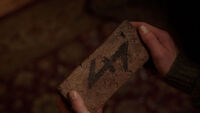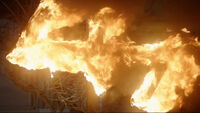mNo edit summary |
mNo edit summary |
||
| Line 10: | Line 10: | ||
** as a political symbol of peasant revolt against German aristocratic oppression; |
** as a political symbol of peasant revolt against German aristocratic oppression; |
||
** as a boundary marker between Hesse and Brunswick-Lüneburg; |
** as a boundary marker between Hesse and Brunswick-Lüneburg; |
||
| − | ** and as an "additional" official symbol of the Hanover forest and hunting staff.<ref name=":1">[https://translate.google.com/translate?sl=auto&tl=en&u=https%3A%2F%2Fwww.wedemark.de%2Fportal%2Fseiten%2Fdie-wolfsangel-918000285-20051.html]''Wolfsangel article from the website of the municipality of Wedemark (in the district of Hanover, in Lower Saxony, Germany)''</ref> |
+ | ** and as an "additional" official symbol of the Hanover forest and hunting staff.<ref name=":1">[https://translate.google.com/translate?sl=auto&tl=en&u=https%3A%2F%2Fwww.wedemark.de%2Fportal%2Fseiten%2Fdie-wolfsangel-918000285-20051.html] ''Wolfsangel article from the website of the municipality of Wedemark (in the district of Hanover, in Lower Saxony, Germany)''</ref> |
* The 1910 German language novel ''Der Wehrwolf'' features a protagonist who chooses the Wolfsangel as a personal mystic symbol. The novel predated the Nazi era, but it contained racist and anti-Semitic ideas which helped its popularity in Nazi Germany.<ref name=":1" /> |
* The 1910 German language novel ''Der Wehrwolf'' features a protagonist who chooses the Wolfsangel as a personal mystic symbol. The novel predated the Nazi era, but it contained racist and anti-Semitic ideas which helped its popularity in Nazi Germany.<ref name=":1" /> |
||
* During the Nazi/Third Reich era, the Wolfsangel was used: |
* During the Nazi/Third Reich era, the Wolfsangel was used: |
||
| − | ** an early symbol for the Nazi Party |
+ | ** as an early symbol for the Nazi Party; |
| − | ** worn on the armband of adjutants of the Hitler Youth |
+ | ** worn on the armband of adjutants of the [[Adolf Hitler|Hitler]] Youth; |
| − | ** later part of the regalia of various German SS armored and infantry divisions |
+ | ** during the later part of the regalia of various German SS armored and infantry divisions; |
| − | ** as the symbol for |
+ | ** as the symbol for {{w|Werwolf}}, a Nazi plan for a civilian resistance/guerilla force combating allied forces at the end of World War II, which operated possibly as late as 1950 in post-surrender Germany and caused "tens of millions of dollars of property damage" and the deaths of "thousands of people".<ref>[https://getpocket.com/explore/item/the-nazi-werewolves-who-terrorized-allied-soldiers-at-the-end-of-wwii?utm_source=pocket-newtab] ''The Nazi Werewolves Who Terrorized Allied Soldiers at the End of WWII, Lorraine Boissoneault, Smithsonian Magazine 2018''</ref><ref>{{w|Werwolf}}</ref> |
| − | ** Ironically, as animal welfare was a significant issue for the Nazi Party, the use of actual Wolfsangels for hunting wolves was made illegal |
+ | ** Ironically, as animal welfare was a significant issue for the Nazi Party, the use of actual Wolfsangels for hunting wolves was made illegal.<ref name=":0" /><ref name=":1" /> |
== References === |
== References === |
||
Revision as of 22:42, 7 August 2020
The Wolfsangel (VOHLFS-ah-ngehl; Ger. "wolf-hook") was originally used as a wolf trap or Blutbaden trap, but it came to symbolize control over all Wesen. It is often used by blood purity organizations such as the Secundum Naturae Ordinem Wesen in attacks against Wesen in inter-marriages. It can also be used as the Wesen version of a burning cross. ("Highway of Tears")
The Secundum Naturae Ordinem Wesen's flag and robes also feature a Wolfangel on them. ("Wesenrein") ("Tribunal")
Trivia
- The Wolfsangel is a non-fictional historic symbol that was indeed derived from a device for trapping wolves. In historically Germanic areas and in modern Germany, it has seen varying usage since the medieval era through the aftermath of WWII:[1]
- as a mason's mark in medieval stonework;
- an element of Germanic heraldry;
- as a political symbol of peasant revolt against German aristocratic oppression;
- as a boundary marker between Hesse and Brunswick-Lüneburg;
- and as an "additional" official symbol of the Hanover forest and hunting staff.[2]
- The 1910 German language novel Der Wehrwolf features a protagonist who chooses the Wolfsangel as a personal mystic symbol. The novel predated the Nazi era, but it contained racist and anti-Semitic ideas which helped its popularity in Nazi Germany.[2]
- During the Nazi/Third Reich era, the Wolfsangel was used:
- as an early symbol for the Nazi Party;
- worn on the armband of adjutants of the Hitler Youth;
- during the later part of the regalia of various German SS armored and infantry divisions;
- as the symbol for Werwolf, a Nazi plan for a civilian resistance/guerilla force combating allied forces at the end of World War II, which operated possibly as late as 1950 in post-surrender Germany and caused "tens of millions of dollars of property damage" and the deaths of "thousands of people".[3][4]
- Ironically, as animal welfare was a significant issue for the Nazi Party, the use of actual Wolfsangels for hunting wolves was made illegal.[1][2]



